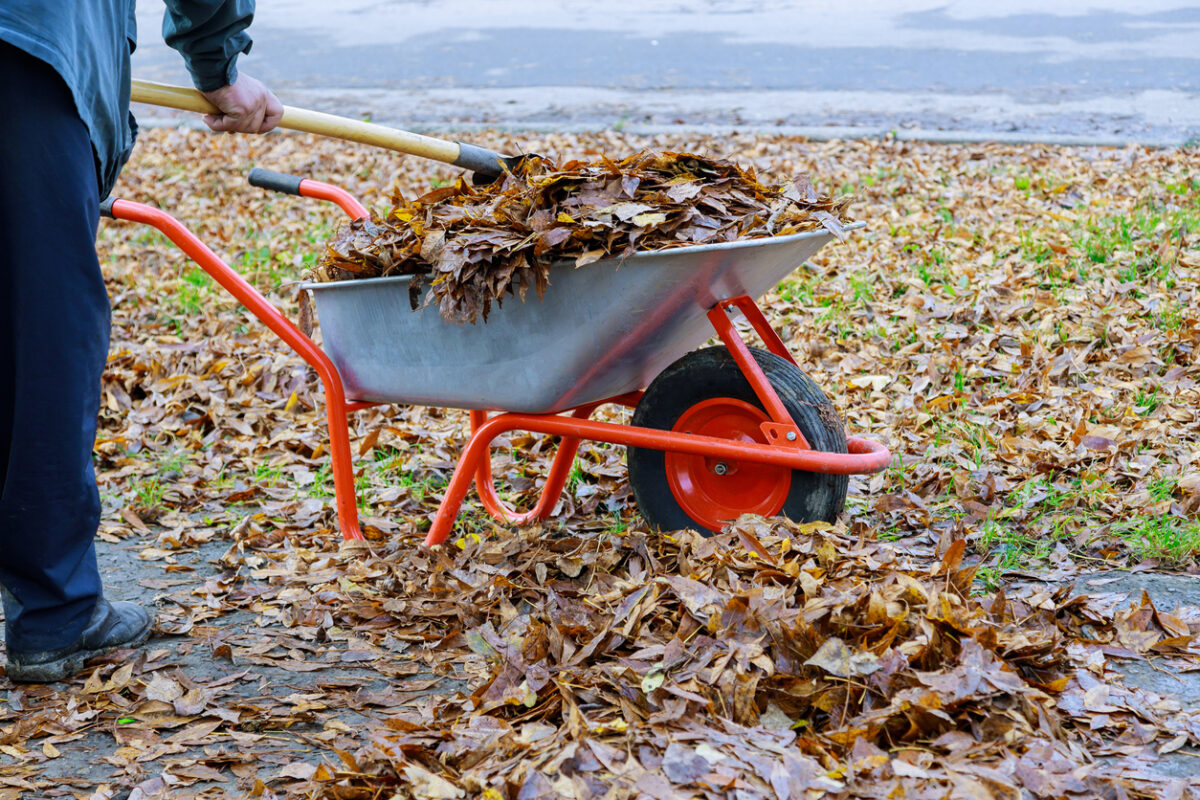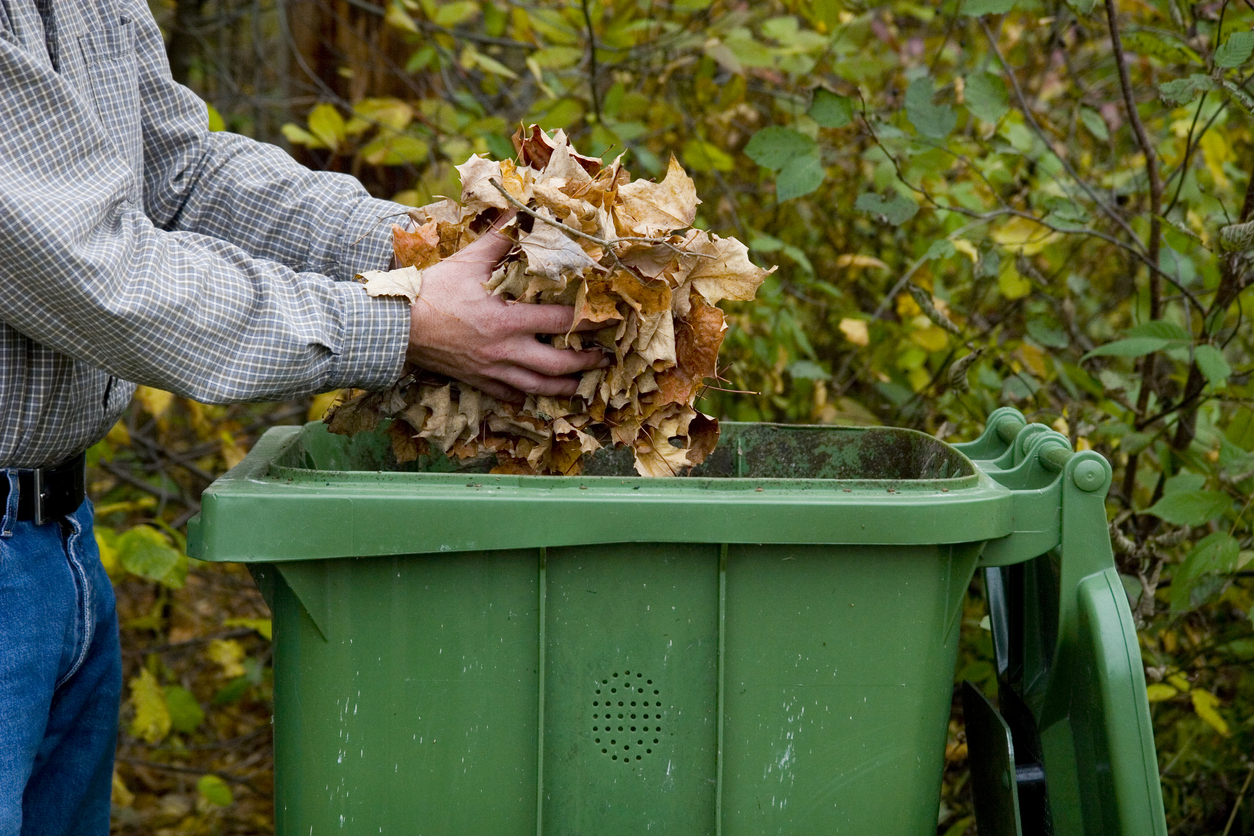

We may earn revenue from the products available on this page and participate in affiliate programs. Learn More ›
Q: I have several large oak trees that cover my yard in leaves every fall. I’m trying to reduce the cost of disposal by reusing them as mulch in our landscape, but they blow around and make a mess. Someone told me that I could turn them into leaf mold, but I’m not really sure what that means. What is leaf mold and how can I use it in my yard?
A: Over the past decade or so, a strong “leave the leaves” movement has risen. Folks are getting the message that fallen leaves offer a host of benefits for landscape plants and wildlife. Plus, skipping the chores of raking, bagging, and hauling leaves away can save time and money. But, as you have noticed, leaving fallen leaves in the yard presents other challenges.
Composting oak leaves into leaf mold is an excellent way to avoid the cost and hassle of leaf disposal, giving your lawn the benefits of recycled leaves while keeping it neat and tidy.
What is leaf mold?
Leaf mold is the dark, crumbly, sweetly earthy-scented compost that comes from decomposing deciduous tree leaves. It is naturally deposited in thin layers on forest floors each year, where it supports a diverse community of soil-dwelling microbes, insects, worms, and plants. Leaf mold greatly improves the structure of sandy or clay soil. This bulky organic material boosts the soil’s water-holding capacity, aeration, drainage, and nutrient-buffering abilities, among many other minor benefits.
Unlike conventional compost, which is quickly broken down in a heat-producing bacterial process, leaves break down slowly in cool, moist conditions, powered almost entirely by fungi. Making leaf mold is far less labor-intensive than conventional composting, but it requires a bit more space and can take up to a year or more to complete. Leaf mold works well when applied on the soil surface or tilled into the upper 2 inches of soil.
Related: 16 Types of Mulch for Landscaping and Gardening
Leaf mold is a superior soil amendment when it comes to moisture retention.
Leaf mold acts as a water reservoir in soil. The porous organic material absorbs water and creates narrow capillary spaces within the soil, improving water movement. The spongy texture efficiently captures excess moisture when it is available and then slowly releases it when conditions are dry.
Leaf mold has proven to boost soil’s water-holding capacity by as much as 50 percent. Applying a 1- to 2-inch layer of leaf mold annually is like buying drought insurance. You can water less frequently, and even the driest weather will impact your plants less severely.

Unlike traditional compost, leaf mold does not contain many beneficial nutrients for plants.
For all of the structural benefits that leaf mold offers, it does not add significant nutrient value to the soil. Although fallen leaves initially contain significant traces of nitrogen, calcium, and numerous other nutrients, these valuable resources do not carry through to the final product. The organisms that break down leaf cellulose use up much of the nutrient content, leaving behind stable, bulky organic material.
Leaf mold does not replace fertilizer, but it creates an environment in which plants can use both conventional and organic fertilizers more efficiently with less potential for runoff pollution. The enhanced soil structure and added organic material provide a better habitat for microbes that consume, store, and transfer nutrients to plants.
Related: This Lawn Fungus Might Be Lurking Beneath the Snow in Your Yard
The type, size, and condition of leaves will affect the rate of decomposition.
The time needed to create a batch of leaf mold can vary from between 6 months and 2 years. Several factors play into the required time, including the type, size, and condition of the leaves. Type and size are connected since broadleaf evergreen leaves, like southern magnolia and holly, are thick and resistant to decay.
Decomposition is enhanced by increased surface area. Smaller, thinner leaves offer more surface area per volume compared to larger, thicker leaves, so they break down faster. For faster results, shred the leaves ahead of processing.
The condition of the leaves matters as well. If they fell in October and got collected in January, they will have begun the decay process already, shortening the time to a complete batch. Moisture is extremely important to the process, so it’s best to begin with wet leaves.
How to Make Leaf Mold
Making leaf mold is easy and mostly passive—plus, it’s fast. Some gardeners simply apply 12- to 24-inch layers of leaves onto landscape and garden beds as mulch and allow them to decompose. But, as noted above, leaves are subject to blowing around. For greater control with slightly more work, leaves can be collected to create a leaf mold pile. Here’s how to make leaf mold in just a few easy steps:
- Create an enclosure. It is possible to simply pile up the leaves, but a leaf compost bin will help to keep leaves from blowing around. Cut a length of 4-foot wire or nylon fencing (about 19 feet for a 6-foot circle, or 13 feet for a 4-foot circle). Fasten it into a circle and place it in a shady location.
- Collect the leaves. Whole leaves will break down over time, but shredded leaves decompose more quickly. Use a lawn mower with a bagger attachment to shred and collect the leaves all at once, or pile them up and use a leaf shredder to grind them to an even finer texture.
- Fill the enclosure. Pack the leaves into the enclosure. For fastest decomposition, wet the leaves as they’re piled up. If the leaves fall in your area over an extended period, it’s fine to continue adding more leaves in batches; the pile will shrink as it decomposes.
- Moisten and cover the pile. When the bin is full, or when all the season’s leaves have been collected, wet the outer surface one more time. Then, cover the pile with a tarp to retain moisture and block sunlight.
- Harvest leaf mold. After a year, check the pile. Leaf mold is ready to use when it is dark brown, soft, and crumbly. The pile will often have an outer layer of dried leaves surrounding the inner pile of finished leaf mold. If this is the case, peel off the outer layer for further processing and harvest the finished product.

Related: Composting 101: How to Put Kitchen and Yard Waste to Work in Your Garden
The Best Ways to Use Leaf Mold in Your Home Landscape
Leaf mold is an ideal mulch and soil amendment for many of the most common gardening applications. Whether growing plants in containers or in the ground, it serves as a superior alternative to store-bought products like peat moss and coir. (And it’s free.)
Since it has not been processed and sterilized, leaf mold adds a dimension of biological activity to the plant root zone. It contains soil-building fungi, which continue to work on coarse organic matter in the soil, and it attracts beneficial insects and earthworms to help with the soil-building and aeration processes. The following are some popular uses for homemade leaf mold compost.
- Incorporate a 2-inch layer of leaf mold into the upper 2 or 3 inches of garden beds for an immediate boost. It works equally well for improving the texture of either sandy or clay-based soils.
- Apply a 2- to 4-inch layer of black leaf mulch to perennial and veggie garden beds. Earthworms and other soil dwellers will carry it deep into the soil for noticeable improvements over time.
- Use leaf mold as a base material instead of peat or coir in homemade potting soil. Add equal parts leaf mold and perlite for a loose soilless mix.
- If weeds have overtaken a garden bed, use leaf mold to reclaim the space. Cut down the weeds at ground level and let them cook in the hot sun for a day. Cover the stressed weed bed with cardboard or thick paper. Apply a 4-inch layer of leaf mold over the top and wait 4 weeks before planting new plants or sowing garden seeds.
